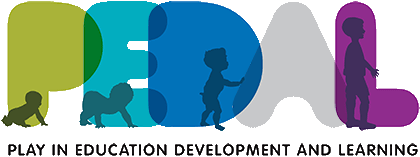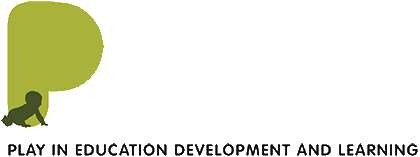This play piece summarises research conducted at PEDAL, in collaboration with The LEGO Foundation. We explored studies looking at whether hands-on activities with physical materials can help children learn. Here we outline what we did and some key takeaways. We end with some tips on how to promote hands-on learning experiences with children.
What are physical manipulatives (PMs)?
Physical manipulatives (PMs) can be any kind of object that children physically interact with during a hands-on activity – things that they can touch, hold, move, or otherwise manipulate with their hands. PMs are great for grabbing children’s attention and encouraging their active engagement in learning.
Some PMs are specially designed to be educational tools, typically for maths teaching. Cast your mind back to your own childhood maths lessons: do you remember using items such as counters, cubes, geometric shapes, or fraction bars? If so, you were using PMs! But PMs don’t have to be specially designed; it can be fun and cost-effective to make your own with whatever materials you have at hand!
There is evidence that children’s early hands-on play is related to their development and early learning. Because of this, researchers have investigated whether educational programmes or interventions involving PMs can enhance children’s learning. While most studies have tested whether PMs are effective during maths instruction, there is a growing body of research investigating the benefits of PMs in other educational areas (e.g., literacy/reading). To explore this research further, we conducted a scoping review.
What is a scoping review?
Scoping reviews are used to map out and describe existing research in a particular field, helping us to see the bigger picture. They also help identify gaps in the research, which guide us towards the kind of work that still needs to be done.
In our review, we aimed to find studies that have tested the effectiveness of PM interventions. Though a scoping review cannot definitively conclude whether PM interventions are effective or not, it can show how this area has been researched so far and summarise the results of relevant studies.
What did we do?
We searched for research papers using online databases, then compiled and reviewed the papers to determine their relevance. We then selected 102 studies for closer review and extracted key information from each report. Our findings are summarised in a 5-page summary and a more detailed PEDAL report, both of which can be found here.
What did we find?
Most studies looked at children between 4-6 years in school settings. While the included studies spanned 26 different countries, almost all took place in high- or middle-income contexts, typically the USA.
What did children experience in the interventions?
- Materials: Children interacted with a range of PMs, such as blocks, puzzles, counters, fraction tiles/pies, geometric shapes, and small toys/figurines.
- Activities: Children used PMs in different hands-on tasks, such as building, making patterns, acting out stories, solving math problems, paper folding, and scientific experimentation.
- Teaching style: While all activities were facilitated by an adult, their involvement differed. In some interventions, children’s actions were directed by an adult and their choice was very limited. Other interventions were play-based, giving children freedom and choice in the tasks with gentle guidance and encouragement from an adult (this approach is called guided play).
- Physical engagement: Some activities, like block building, required children to engage in substantial amounts of physical interaction with materials, whereas others required less, with children simply touching or moving items (e.g., when counting tokens or sorting shapes).
How did studies test whether PM interventions are effective?
- Methods: Most studies included a control group to test if PM interventions were better, worse, or the same as other learning experiences. Several studies had very good methodologies, meaning their results are trustworthy. However, many other studies were hindered by methodological issues (e.g., small sample size, no control group), meaning their results are less reliable.
- Learning measures: All interventions aimed to benefit children’s learning in some way but differed in the type of learning they targeted. Consequently, many different outcome measures were administered across the studies (e.g., related to math, literacy, science, visual-spatial skills).
Are PM interventions effective?
Overall, findings about the effectiveness of PM interventions were mixed. Some studies reported benefits to children’s math, spatial, or literacy skills following PM activities. A couple of example studies are highlighted here:
- Math lessons in some lower-income contexts are often directed by teachers using techniques like drill and memorisation. In Belize, a more child-centred and hands-on approach, involving cost-effective homemade PMs and ongoing support for teachers, was used to encourage children’s active participation in math learning. The intervention improved children’s overall math ability, leading to a nationwide rollout of the programme.1
- After storytime, pre-schoolers in the USA were encouraged to play with story-relevant items (e.g., farm-related toys like animals and tractors). An adult supported their play and incorporated key vocabulary, leading to benefits in their vocabulary.2
However, many other studies did not find benefits to children’s learning or had inconclusive results, often due to methodological problems. Because of this, we must be cautious about drawing conclusions about the overall effectiveness of PM interventions.
In light of these results, we suggest some future directions for research:
- We need more geographically diverse research, especially in lower-income countries.
- We need better quality research that yields stronger and more reliable results.
- We need educational programmes that are designed or adapted to meet the specific needs of their target population (e.g., addressing lack of teacher training or resources).
Top tips for using PMs
While more work is needed to understand how programmes involving PMs can help children learn, the research we found highlights the many ways PMs may promote children’s active involvement in learning, and how they can be used to facilitate child-centred and playful learning experiences. Crucially, PMs by themselves don’t guarantee learning – it matters how they are used, and how children are supported. Here are some tips on incorporating PMs into learning activities:
- Adult involvement: While PMs easily grab children’s attention, they may distract them from the intended learning goal and encourage off-task behaviour. Therefore, it’s important to monitor how children are using PMs and gently guide them.
- PMs & math: Math can be difficult because it involves abstract (i.e., symbolic) concepts. PMs can be used to introduce these quite complex ideas in a concrete way. For example, by interacting with fraction blocks, children can see and feel a half compared to a whole. This provides them with foundational knowledge about fractions before learning using numbers/symbols.
- PMs & literacy: Encourage children to read and act out stories with related toys/props. Incorporate language from the story to help them learn new words.
- PMs & science: Encourage children to be scientists by conducting their own experiments with PMs! They can make predictions and test their ideas (e.g., by dropping different items to learn about gravity).

Useful reading
1Teacher-Led Math Inquiry: A Cluster Randomized Trial in Belize. Educational Evaluation and Policy Analysis (Hull, Hinerman, Ferguson, Chen & Näslund-Hadley, 2018)
2Mathematics for the future: developing a Head Start curriculum to support mathematics learning. Early Childhood Research Quarterly (Sophian, 2004)

